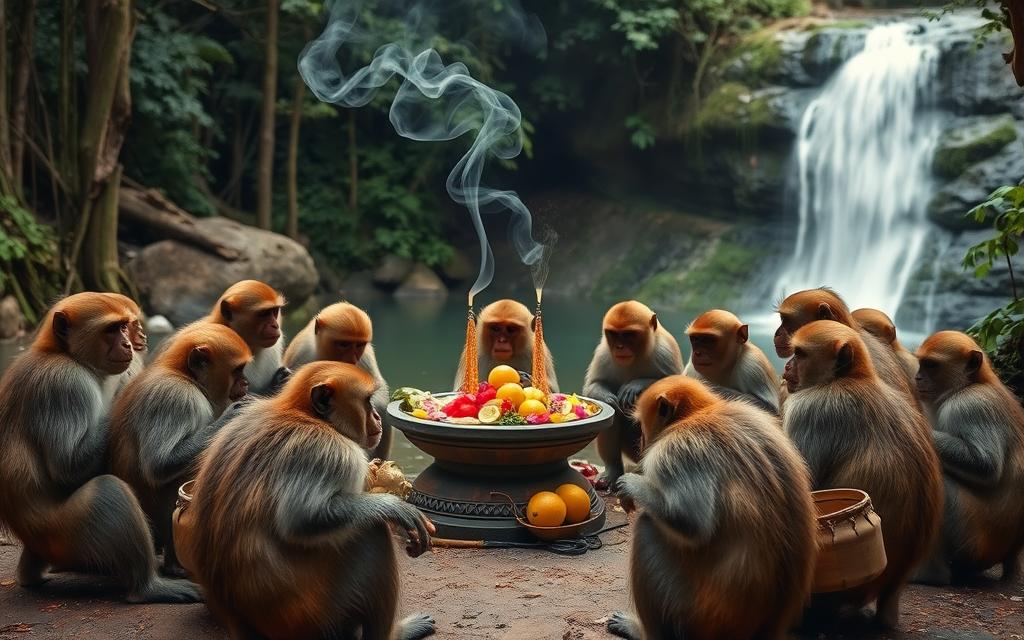
Sacred Monkey Forest’s Cultural Practices and Rituals
Did you know the Sacred Monkey Forest in Ubud, Bali, covers about 27 acres? It’s home to over 1,260 long-tailed macaques in 10 groups12. This place is more than a home for the monkeys. It shows off Balinese culture and Hindu traditions. Visitors can feel the mix of spirituality and nature.
The Cultural Practices and Rituals of the Sacred Monkey Forest show the deep beliefs of the Balinese people. They live in harmony with nature. Every ritual, from temple ceremonies to conservation, shows their love for the land and its creatures. This place is special for those who love nature and spirituality.
Key Takeaways
- The Sacred Monkey Forest spans 27 acres and is home to over 1,260 long-tailed macaques.
- Visitors can experience the Cultural Practices and Rituals of the Sacred Monkey Forest, which reflect the community’s dedication to preserving their cultural heritage.
- Approximately 186 species of plants and trees, including sacred temples, are found in the forest.
- It serves as a vital sanctuary for wildlife, integrating animal welfare and conservation into the local customs.
- Daily, around 10,000 to 15,000 visitors explore the forest, linking tourism with cultural education.
Introduction to the Sacred Monkey Forest
The Sacred Monkey Forest is in Ubud and covers about 27 acres. It’s a key spot for both visitors and locals3. Here, you’ll find around 600 long-tailed macaques, seen as sacred in Balinese culture4.
This place is crucial for over 100 tree species and welcomes over 10,000 tourists monthly3. You can see temples where wildlife and spiritual life meet4.
Visiting the Sacred Monkey Forest lets you learn about its history and the need to protect nature. You’ll see playful macaques and learn about Balinese Hindu traditions5. With tours and photo spots, it shows the beauty of nature and spirituality in Ubud.
Historical Significance of Monkey Forest Ubud
The historical significance of Monkey Forest Ubud goes way back to the 14th century. It started as a sacred place and became a sanctuary. It’s where spirituality and nature come together.
This forest is known for its deep cultural and natural value. Over time, it has changed but still holds a special place in people’s hearts.
Origins and Evolution Through the Centuries
The Monkey Forest has been important to the local community for centuries. It covers 27 acres and is home to over 600 long-tailed macaques. These monkeys live in four groups, linking wildlife with Balinese cultural heritage6.
This place is also a key spot for studying monkey behavior and their environment7. It shows how important it is for protecting nature worldwide.
Connection to Balinese Cultural Heritage
The forest is a key part of Balinese culture. It shows how rituals and nature work together. Each temple in the forest is a sacred spot for rituals that bring people together.
These rituals, like Tumpek Kandang and Tumpek Uduh, focus on animals and plants. They show the idea of Tri Hita Karana. This idea is all about living in harmony with nature and the divine7.
Cultural Practices and Rituals of the Sacred Monkey Forest
In Balinese Hinduism, rituals are key to spiritual life. They link the physical and spiritual worlds. This lets people connect with ancestors, gods, and nature. The Sacred Monkey Forest is a place where these rituals happen, with offerings and prayers being central.
These rituals honor traditions and show the deep spiritual meaning. They help keep the community in harmony.
Understanding the Role of Rituals in Balinese Hinduism
Rituals in the Sacred Monkey Forest show what Balinese Hinduism is all about. Each ceremony helps the community’s spiritual health. It builds a deep bond between people, nature, and the gods.
Locals take part, showing how important these rituals are. The Forest Sanctuary is a place for both tourists and the community to find spiritual peace8. These rituals bring people together, keeping traditions alive and promoting peace.
Importance of the Tri Hita Karana Concept
The Tri Hita Karana idea is key to Balinese thought. It talks about three main relationships: human connections, human-nature bonds, and human-divine ties. The Sacred Monkey Forest shows this idea in action, with rituals that keep these relationships balanced.
Visitors see how locals use the forest for spiritual balance. Nature and spirituality blend in rituals, showing how Balinese culture values interdependence. Exploring this place helps you see the effort to keep spirits high and follow Tri Hita Karana’s teachings.
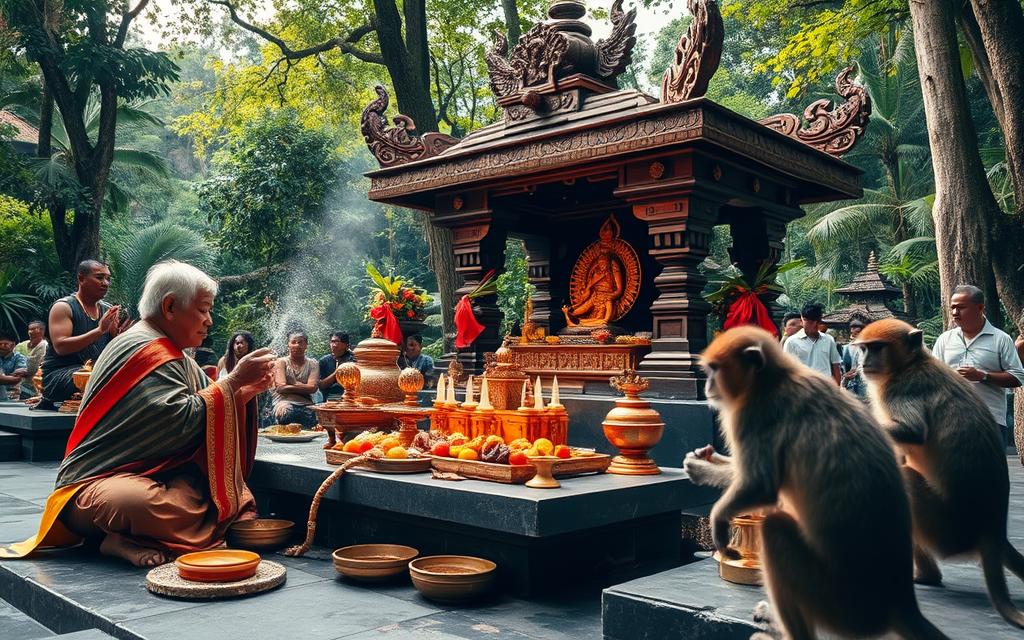
Temple Ceremonies within the Sacred Area
The temple ceremonies in the Sacred Monkey Forest are very important to Balinese culture. At the heart of these rituals is the Ngaben, a special cremation ceremony. It shows the deep spiritual meaning of life and death.
Ngaben: The Balinese Hindu Cremation Ritual
Ngaben is more than just a serious event; it’s a colorful celebration of beliefs. It includes building fancy structures, saying prayers, and dressing the deceased in beautiful clothes. Despite being about death, the ceremony is filled with joy. It celebrates life’s cycle and the soul’s journey to the afterlife.
Families come together to honor their loved ones, making it a key event for community bonding9.
Purification Practices at the Holy Spring Bathing Temple
The Holy Spring Bathing Temple is near Ubud Monkey Forest and is key for purification. It has sacred springs that clean the soul. People, including those attending funerals, dip in the holy water to start anew.
This act means rebirth and ties with Balinese Hinduism, linking with the Ngaben ceremony. The temple’s practices connect the community to their spiritual heritage. They highlight the need for cleansing through life’s changes10.
The Sacred Monkeys and Their Cultural Role
In Balinese culture, monkeys are very important. They are part of local myths and stories. They show many sides of nature in tales like the Ramayana.
Monkeys are seen as protectors and tricksters. This mix shows their deep cultural meaning. It affects how people see and treat them, especially in the Sacred Monkey Forest.
People see them as guardians of their heritage. Stories about monkeys in Balinese myths help us understand their role in the community.
Symbolism of Monkeys in Balinese Myths
There are over 700 monkeys in the Ubud Monkey Forest. They show the importance of nature. In stories, they show human-like traits.
They guard temples, reminding us of nature’s balance. Their actions teach us about respect and care for nature. Efforts focus on animal welfare and environmental significance.
Conservation Efforts and Animal Welfare
Managing the monkey population is tricky. It’s about monkey conservation and teaching visitors to respect wildlife. Local groups push for animal welfare and focus on the environment.
Research combines behavior studies with cultural insights. This helps humans and monkeys live together better. Monkey forests in Bali are important for tourism and conservation. They help keep culture and nature in balance111213.
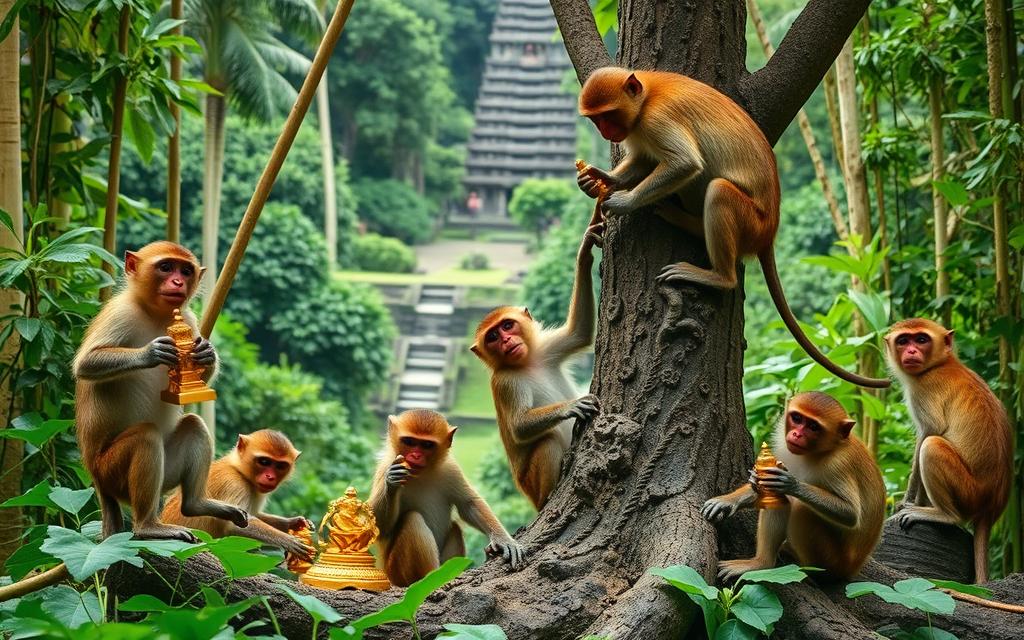
Significance of Sacred Trees in the Monkey Forest
The sacred trees in the Monkey Forest are more than just beautiful. They are very important in Balinese culture. Trees like the Pule Bandak are used in many rituals, showing their deep spiritual value.
These trees help keep cultural traditions alive. They let people make offerings and hold ceremonies to honor the spirits living in them. This shows how much the local people value these ancient trees.
Impact of Trees in Spiritual Practices
Sacred trees in the Monkey Forest have a big impact on spiritual life. They are part of many rituals for the Balinese people. With 115 different tree species, some are seen as holy and used in rituals to keep balance in life7.
These trees help people connect with nature and the divine. They follow the philosophy of Tri Hita Karana, which means living in harmony with the environment and God7.
Research and Conservation of Biodiversity
The Monkey Forest is a key place for many tree species, with 186 types found there11. Scientists study how monkeys live together, helping with conservation efforts7. This research helps us understand the forest better and how to protect it.
It also shows the importance of keeping the forest safe for both people and nature. The research helps with efforts to save this special place, making Ubud a key spot for protecting nature.
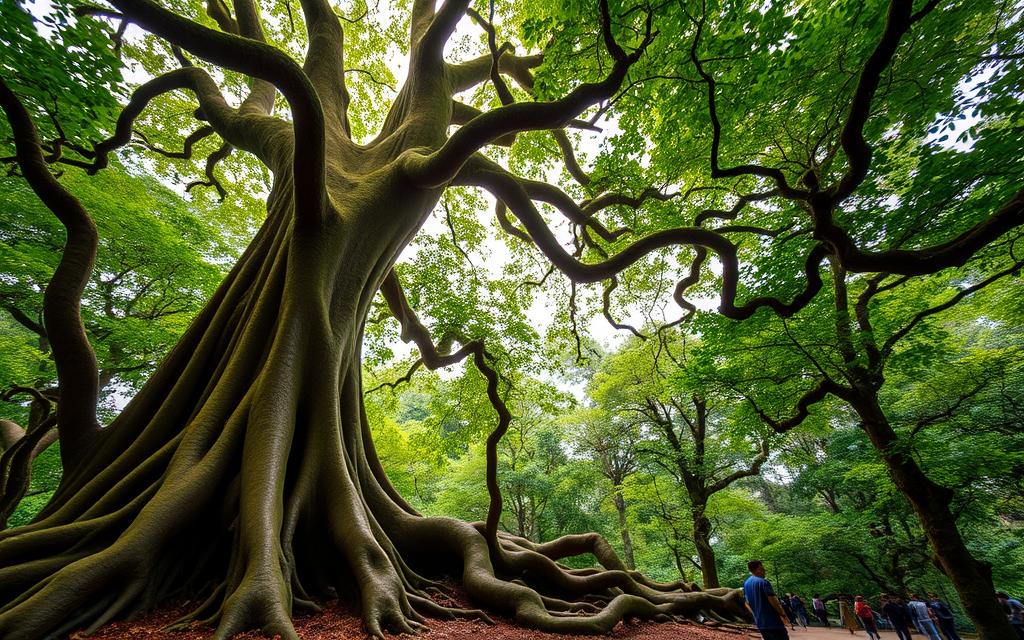
Eco-Tourism and Its Role in Preservation
Eco-tourism is key to saving the Sacred Monkey Forest. It teaches visitors about the local area and culture. It also helps the community. With millions visiting Bali yearly, eco-tourism’s effect is huge.
Eco-tourism can make up to US$30 billion a year. This helps local communities use sustainable ways14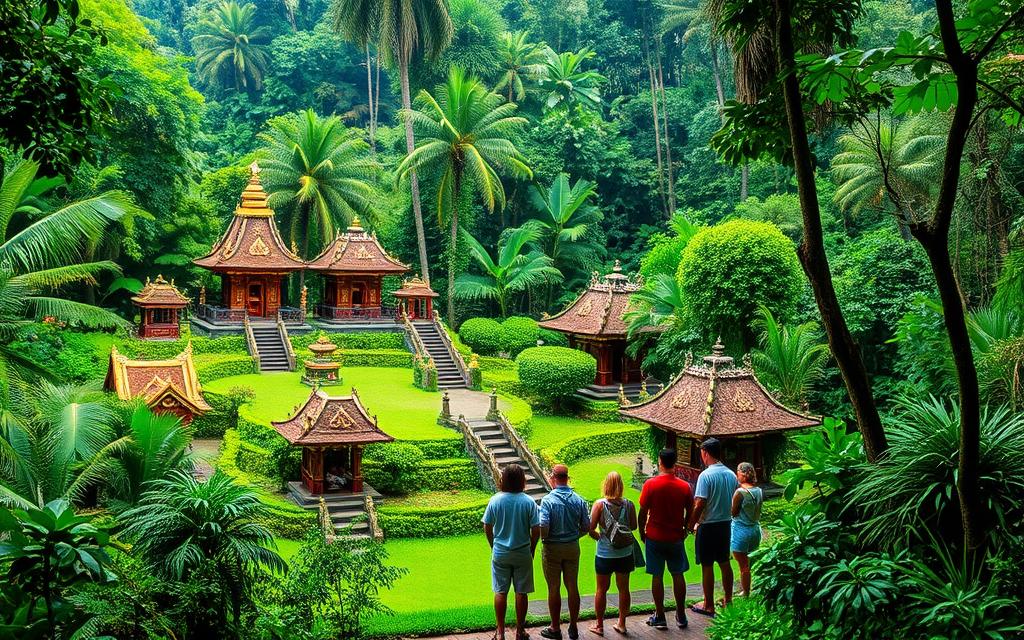
Balancing Tourism and Conservation Efforts
It’s important to balance tourists with conservation. Fast tourism growth has caused deforestation and lost land in Bali. Eco-tourism helps protect the environment.
It teaches guests about local ways and how to protect nature. Many eco-tourists choose to stay in places owned by locals. This keeps money in the community15.
Visitor Engagement and Responsible Tourism
Getting visitors involved is key to responsible tourism. Educational programs teach the value of saving nature and how to be respectful. They connect visitors with the local community.
This builds a love for the forest’s culture. It also helps with economic issues and improves local life. This makes tourism better for the planet1415.
Community Involvement in Rituals and Practices
Local villagers are key to keeping the Sacred Monkey Forest’s rituals strong. They take part in many ceremonies, deepening their spiritual bond. This helps keep Balinese traditions alive for the next generations.
Role of Local Villagers in Maintenance and Rituals
Villagers do many important jobs in the Monkey Forest. They join in ceremonies and help with daily care. These activities bring people together, making them feel part of something special.
Festivals and Community Gatherings in the Forest
Festivals in the Monkey Forest show off Balinese culture. They are times of joy and unity for the villagers. These events teach us about their traditions and bring people closer to nature.
The Sacred Monkey Forest is full of life thanks to the villagers. They keep the traditions going with their rituals and festivals. This makes the forest a spiritual place for everyone161718.
Cultural Tapestry of Balinese Dance and Music
Balinese dance is a key part of the island’s culture. It tells stories with movement and rhythm. The Frog Dance, or Tari Katak, is a favorite. It shows the island’s creativity and tells stories of loyalty and perseverance.
Exploring Traditional Dances like the Frog Dance
Balinese dance is closely linked to Hindu beliefs on the island. It’s often seen in sacred places, showing its deep religious meaning. Dancers act as spiritual beings, playing the roles of deities, adding to the dance’s importance19.
Each dance shares deep messages about the island’s culture and values. It mixes spirituality with art20.
The Influence of Music on Balinese Rituals
Music is key in Balinese rituals and dance. It sets the mood for ceremonies. Before dances, purification ceremonies prepare everyone spiritually19.
Audiences play a big part in these events. They join in, making the experience better for everyone. At the Saraswati ceremony, they make offerings, helping keep the culture alive19.
Challenges and Opportunities Ahead
More tourists are coming to Ubud, making it key to keep both wildlife and visitors safe. We must understand why monkeys act aggressively and keep visitors safe. This way, everyone can enjoy their time together more.
Using signs and guided tours can help solve these problems. It makes visiting better for everyone. It’s important to keep the monkeys safe and make sure guests are safe too. This is key for the Sacred Monkey Forest to last21.
Addressing Wildlife and Visitor Safety
There are about 600 monkeys in the Ubud Monkey Forest Sanctuary. We need to keep them and visitors safe. This means dealing with crowds, making it easy to get around, and providing shade in the forest.
By fixing facilities and teaching visitors, we can manage safety better224.
Future of Cultural Practices amid Modernization
Modern changes bring both good and bad for cultural practices in the Sacred Monkey Forest. It’s vital to keep focusing on preserving our heritage and traditions. Working with the local community helps keep Bali’s culture alive, even with more tourists and global changes.
Conclusion
The Sacred Monkey Forest is a special place where culture and nature meet. It shows off Balinese culture and spirituality in a big way. The forest is about 27 acres big and has over 700 long-tailed macaques living there. It also has three old temples from the 14th century233>.
Walking through, you see how people, tourism, and old traditions work together. They help protect the animals and the area’s culture. This shows how important it is to keep the natural world and culture safe.
There are rules for visitors to keep the monkeys safe and happy23. The Padangtegal Wenara Wana Foundation works hard to protect the area and its traditions23. Money from tickets goes back into protecting nature and helping the community. This way, the forest and the people living nearby can both do well.
Going to the Sacred Monkey Forest is more than seeing cool animals. It’s a chance to see how people and nature live together. You’ll learn about the importance of keeping nature safe for the future2425.
FAQ
What is the Sacred Monkey Forest?
The Sacred Monkey Forest is in Ubud, Bali. It’s a place with over 600 long-tailed macaques. It’s important for its culture and nature, showing how people and nature connect.
How do Balinese Hindu rituals manifest in the Monkey Forest?
Rituals include offerings and prayers. They help keep humans, nature, and the divine in balance. These acts show the area’s spiritual value and bring people together.
What is the role of the monkeys in Balinese culture?
Monkeys are seen as guardians, like in the Ramayana. They show the beauty and complexity of nature. This helps teach us to love and respect wildlife, supporting conservation.
What kind of ceremonies take place in the Sacred Monkey Forest?
The forest has many ceremonies. The Ngaben is a cremation ritual that shows the soul’s journey. Purification rituals at the Holy Spring Bathing Temple help with spiritual renewal.
How does eco-tourism contribute to the preservation of the Monkey Forest?
Eco-tourism teaches visitors about Balinese culture and conservation. It encourages sustainable ways to interact with nature and wildlife. This helps protect the environment and culture.
What is the Tri Hita Karana concept?
Tri Hita Karana means living in balance with humans, nature, and the divine. It shows how everything is connected, just like in the rituals at the Sacred Monkey Forest.
How do local villagers participate in the Monkey Forest’s cultural practices?
Villagers take part in rituals and ceremonies. This keeps traditions alive for future generations. Their role is crucial for the forest’s cultural strength.
What challenges does the Monkey Forest face amid increasing tourism?
The forest must balance safety for the monkeys and visitors. It’s important to manage how people interact with the sacred monkeys. This helps protect them and keep the forest sustainable.
Why are sacred trees important in the Sacred Monkey Forest?
Sacred trees, like the Pule Bandak, are key to Balinese spirituality. They’re used in rituals and offerings. These trees connect us to the spiritual world and add to the forest’s cultural and natural value.
Source Links
- https://woodsbali.com/blog/primates-nature-and-culture-ubud-monkey-forest/
- https://en.wikipedia.org/wiki/Ubud_Monkey_Forest
- https://villaamrita.com/monkey-forest-ubud-in-bali/
- https://baligram.me/blog/ubud-monkey-forest-sanctuary-a-sacred-place-where-monkeys-rule
- https://byemyself.com/ubud-culture-tradition-and-monkey/
- https://www.departful.com/2014/03/monkey-forest-sanctuary-ubud-indonesia/
- https://monkeyforestubud.com/about-us/
- https://destinationlesstravel.com/ubud-monkey-forest-bali/
- https://dukesglobaladventures.com/2023/11/24/ubud-monkey-forest-sanctuary/
- https://pickyourtrail.com/attractions/ubud-monkey-forest-bali
- https://medium.com/@daniela.puglisi/ubud-balis-cultural-heart-monkey-forest-tegalalang-rice-terraces-d29dfb6cb38d
- https://theltmproject.org/wp-content/uploads/2022/04/natural-cultural-encounters-in-bali_-monkeys-temples-tourists-and-ethnoprimatology.pdf
- https://www.cambridge.org/core/books/ethnoprimatology/sacred-monkeys-an-ethnographic-perspective-on-macaque-sacredness-in-balinese-hinduism/28AFA42CA36C9F81717DE6ACEA75F46E
- https://pure.bond.edu.au/ws/portalfiles/portal/28737964/Development_of_eco_tourism.pdf
- https://growfish.co/sustainable-marketing-in-bali-transforming-the-tourism-industry/
- https://guideyourtravel.com/read-this-before-visiting-the-monkey-forest-in-ubud-bali/
- https://warriorsdivine.com/blogs/the-path/embracing-ubud-a-guide-to-balis-spiritual-heart
- https://www.tourhero.com/en/magazine/culture-tradition/cultural-experiences-in-bali-to-add-to-your-destination-wellness-retreat/
- https://warriorsdivine.com/blogs/the-path/balinese-dance-the-spiritual-language-of-the-island?srsltid=AfmBOooYo3P7flbN32gs_kAhwhaQlXChJEthhQRK_i2CQX9EVMT-BBiO
- https://www.ubudvillasrental.com/traditional-dance-the-cultural-treasure/
- https://warriorsdivine.com/blogs/the-path/embracing-ubud-a-guide-to-balis-spiritual-heart?srsltid=AfmBOooSgKuy1ilK-EhpcIMW-DDUvI2_6kTL9EawNn6Y9zz0nIUTdk0Q
- https://www.kimkim.com/c/bali-s-rituals-cuisine-13-days
- https://www.ubudkayahouse.com/article/monkey-forest-ubud
- https://www.raftingbali.net/bali-cultural-tourism/
- https://planittrips.com/ubud-sacred-monkey-forest-sanctuary/